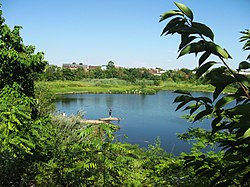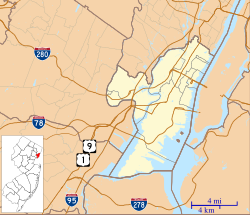Jersey City Reservoir No. 3
Jersey City Reservoir 2 and 3 | |
 | |
 | |
| Location | Central Avenue & Summit Avenue Jersey City, New Jersey, USA |
|---|---|
| Coordinates | 40°44′25″N 74°03′17″W / 40.7402°N 74.0546°WCoordinates: 40°44′25″N 74°03′17″W / 40.7402°N 74.0546°W |
| Area | 13.8 acres (5.6 ha) |
| Built | 1870 |
| Architectural style | Egyptian Revival Romanesque Revival |
| NRHP reference No. | 12000569[1] |
| NJRHP No. | 1512[1] |
| Significant dates | |
| Added to NRHP | August 27, 2012 |
| Designated NJRHP | April 10, 2012 |
Jersey City Reservoir No. 3 is a decommissioned reservoir atop Bergen Hill in the Heights of Jersey City, Hudson County, New Jersey, United States, situated on approximately 13.8 acres (5.6 ha) just south of Pershing Field. It was built between 1871 and 1874 as part of the city's waterworks system designed to provide potable water to the city, including Ellis Island. Its perimeter wall is in the Egyptian Revival style and pump stations are in the Romanesque Revival style. The reservoir provided drinking water until the 1980s, when it was drained and abandoned for a larger reservoir at the Boonton Gorge. Since that time, a mini-ecosystem has taken root behind the thick, 20-foot tall stone walls: trees, wildflowers, swans, great blue heron, peregrine falcons, and at the center a 6-acre (2.4 ha) lake. This urban wildlife preserve hosts numerous animal and plant species not otherwise found in an urban environment.[2][3][4][5][6][7] It was listed on the state and the federal registers of historic places in 2012.[1] Nearby Reservoir No. 1 was located on either side of Summit Avenue and has been demolished.[8]
The Jersey City Reservoir Preservation Alliance, started in 2002, runs the maintenance and supervision programs necessary to keep the park open to the public every Saturday from May–October. The Alliance also runs summertime programming in arts, music, and recreation to bring new and returning community members to the space. The Alliance received the Ted Conrad “Preservationist of the Year” Award in 2005.[citation needed]
Plans to make changes to the wlldlife area by the city have been met with resistance from preservatonists.[9]
See also[]

- Hackensack Water Company Complex
- National Register of Historic Places listings in Hudson County, New Jersey
- Jersey City Reservoir Preservation Alliance
References[]
- ^ Jump up to: a b c "New Jersey and National Registers of Historic Places - Hudson County". New Jersey Department of Environmental Protection - Historic Preservation Office. Retrieved 2016-01-19.
- ^ "Reservoir No. 3 Historic Preservation Plan (RFP)" (PDF). City of Jersey City. 2009. Retrieved 2012-02-22.
- ^ "Jersey City Water Works". Jersey City A to Z. New Jersey City University. Archived from the original on 2009-01-09. Retrieved 2012-02-22.
- ^ "Jersey City Water Works (Reservoir 3)". Jersey City A to Z. New Jersey City University. Archived from the original on 2012-01-16. Retrieved 2012-02-22.
- ^ "Reservoir No. 3". Jersey City Landmarks Conservancy. Archived from the original on 2012-03-01. Retrieved 2012-02-22.
- ^ "Pershing Field". 1921: Jersey City Under Commission Government A Book of Achievement. City of Jersey City. 1921. Retrieved 2012-02-22.
- ^ "Jersey City's Water Supply". 1921: Jersey City Under Commission Government A Book of Achievement. City of Jersey City. 1921. Retrieved 2012-02-22.
- ^ TAM Associates (May 2001). Jersey City Reservoir #3 (PDF). Jersey City Recreation Master Plan (Report). City of Jersey City. p. 101. Retrieved 2012-02-26.
- ^ "Jersey City planning to make $2.5M in safety upgrades at historic reservoir, but local group isn't on board". 12 March 2021.
External links[]
- Reservoirs in New Jersey
- Buildings and structures in Jersey City, New Jersey
- Buildings and structures on the National Register of Historic Places in New Jersey
- Egyptian Revival architecture in the United States
- Buildings and structures completed in 1874
- Romanesque Revival architecture in New Jersey
- Tourist attractions in Jersey City, New Jersey
- National Register of Historic Places in Hudson County, New Jersey
- Bodies of water of Hudson County, New Jersey
- New Jersey Register of Historic Places
- Parks in Hudson County, New Jersey


